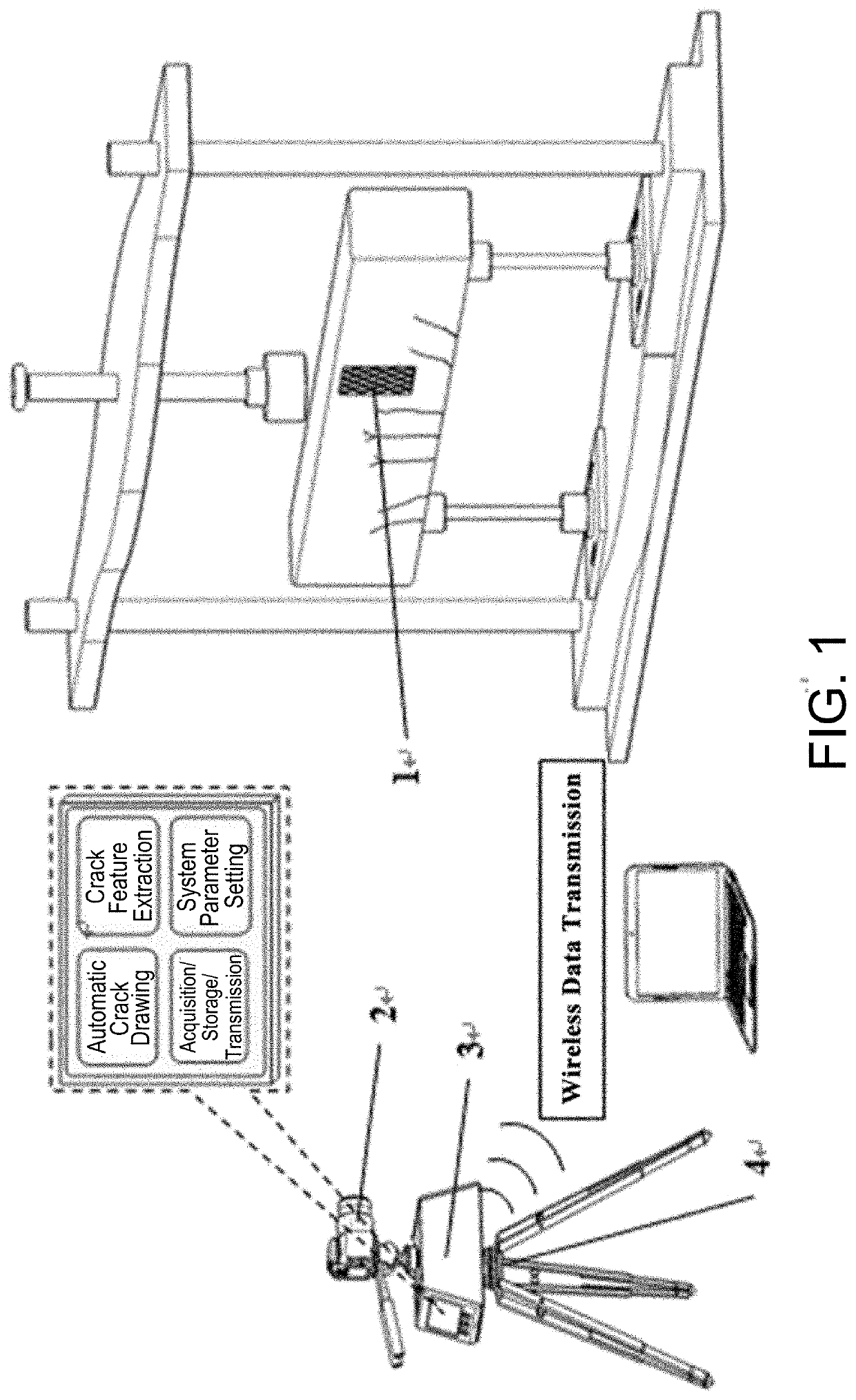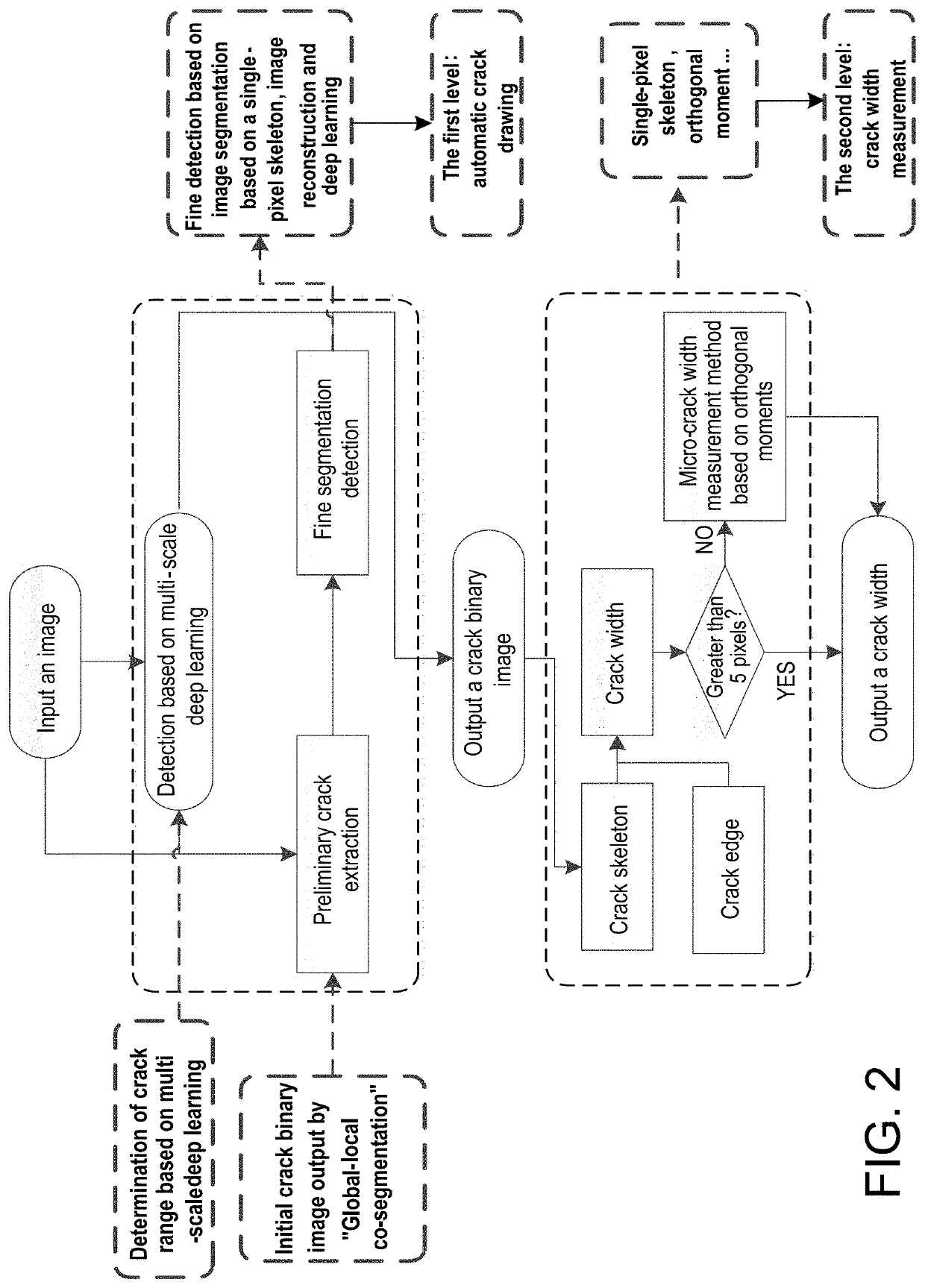Method and device for automatically drawing structural cracks and precisely measuring widths thereof
a technology of structural cracks and widths, applied in the field of structure detection and evaluation, can solve the problems of more human intervention, mainly observed cracks, and difficult to determine whether it is a crack according to features identified by a conventional algorithm, and achieve the effects of high accuracy, high recall, and high precision
- Summary
- Abstract
- Description
- Claims
- Application Information
AI Technical Summary
Benefits of technology
Problems solved by technology
Method used
Image
Examples
example 1
[0072]A method for automatically drawing structural cracks As shown in FIG. 3, the method for automatically drawing structural cracks comprises the following steps: 1) detecting, by a crack detection method based on multi-scale deep learning, a crack range in an image using multi-scale deep learning to ensure that no crack information is missed for subsequent work; 2) extracting, by a preliminary crack extraction method of “global-local co-segmentation” based on deep learning, median filtering and Hessian matrix-based linear enhancement, full information of both macro-cracks and micro-cracks in the image to ensure a detection result of high recall; and 3) effectively removing, by a fine crack detection method based on deep learning, image segmentation and image reconstruction, noise from the result to ensure a detection result of high accuracy and precision. The crack detection method based on multi-scale deep learning in step 1) is specifically as follows: Because concrete cracks a...
example 2
[0098]A method for precisely measuring crack widths based on a single-pixel crack skeleton and Zernike orthogonal moments Conventional methods for calculating crack widths, which calculate the distance between two pixels by “pixel counting”, works badly in calculating the width of a crack less than 5 pixels. Therefore, for cracks smaller than 5 pixels in images, the present invention proposes a method for calculating crack widths based on a single-pixel skeleton and Zernike orthogonal moments, as shown in FIG. 6.
[0099]The method for calculating crack widths based on a single-pixel skeleton and Zernike orthogonal moments utilizes a single-pixel skeleton to determine a rotation angle for an image. The image at this point is rotated, symmetrized and mirrored to obtain two images symmetrical with respect to the y coordinate axis. The second-order orthogonal moment A′20 and the fourth-order orthogonal moment A′40 are calculated respectively for the two symmetrical images by utilizing Ort...
example 3
[0104]A device for automatically drawing cracks of a concrete specimen and measuring widths thereof in a laboratory As shown in FIG. 1, the device comprises an image calibration module 1, an image acquisition module 2, an image processing system 3, and a camera tripod 4.
[0105]The device for automatically drawing structural cracks and precisely measuring widths thereof can rapidly and automatically draw structural cracks on a surface and precisely measure crack widths.
[0106]The image calibration module 1 is configured to correct the pose of a camera, calculate the resolution of an image, and paste a plurality of manually-printed checkerboards with a known size on the surface of a concrete specimen; the image acquisition module 2 composed of a single lens reflex camera is mainly configured to acquire a high-resolution image of the concrete specimen for image processing in the next step; and the image processing system 3 is embedded with an automatic crack drawing algorithm module, a c...
PUM
 Login to View More
Login to View More Abstract
Description
Claims
Application Information
 Login to View More
Login to View More - R&D
- Intellectual Property
- Life Sciences
- Materials
- Tech Scout
- Unparalleled Data Quality
- Higher Quality Content
- 60% Fewer Hallucinations
Browse by: Latest US Patents, China's latest patents, Technical Efficacy Thesaurus, Application Domain, Technology Topic, Popular Technical Reports.
© 2025 PatSnap. All rights reserved.Legal|Privacy policy|Modern Slavery Act Transparency Statement|Sitemap|About US| Contact US: help@patsnap.com



